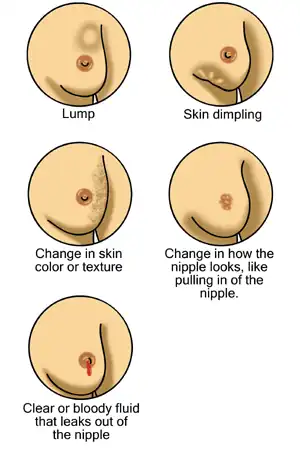Breast examination
| Breast examination | |
|---|---|
_(13).jpg.webp) | |
| Clinical breast examination | |
| Specialty | Surgery |
| Indications | Signs and symptoms in breast, family history of breast disease, after abnormal breast screening[1] |
| Contraindications | No consent[2] |
| Steps |
|
| Complications | False reassurance, unnecessary investigations[3] |
Breast examination, also known as clinical breast examination, is a physical examination performed by a medical professional on an individual presenting with signs and symptoms in a breast, periodically on some people with a family history of breast disease, or on a person with an incidental abnormal finding on imaging such as mammography.[1][4]
Techniques may vary from one medical professional to another, but essentially follow the principles of obtaining informed consent, inspecting and then palpating the breasts, followed by looking for nearby lymph nodes.[2][5] It is not performed on a person who does not co-operate or consent.[2] A chaperone is offered prior to beginning the examination.[6] The method is similar in both males and females.[2]
Examination findings are generally reported using particular terms; size, symmetry, texture, description of any mass and appearance of the skin.[2] Some organisations recommend a breast examination as part of routine screening, typically in some high risk groups.[2]
Indications
A breast examination is performed on an individual who complains of pain in a breast, skin changes, nipple discharge, breast mass, or major changes in size or shape of a breast.[2] It is also recommended if there is an incidental abnormality on imaging of the breast; mammogram, ultrasound, MRI, CT scan, and PET scan.[2] Some people with a family history of breast disease may require a regular breast examination, typically performed annually.[1] Frequently, the individual seeking medical attention has already examined their breasts themselves and found a lump, skin change, pain or nipple discharge.[2]
The American Cancer Society, American College of Obstetricians and Gynecologists, and the United States Preventive Services Task Force, differ somewhat in their recommendations of whom not to recommend routine breast examination for.[4]
Preparation
Careful explanation may help reduce anxiety.[2] Typically, a female chaperone for a female examination and male chaperone for a male examination is present.[2]
Procedure
Techniques may vary from one medical professional to another, but essentially follow the principles of obtaining informed consent, inspecting and then palpating the breasts, followed by looking for nearby lymph nodes.[2]
| Instruction | Image | |
|---|---|---|
| 1. | Request individual to rest hands on hips/thighs to relax chest wall muscles.[1] | .jpg.webp) |
| 2. | Inspect size, shape and appearance of breast.[5] Look for asymmetry, local swelling, skin changes, or nipple discharge.[1] Note any retraction of skin, ulceration, redness, or crusting of nipples.[5] Note if nipples are inverted, everted, or flat.[5] | _(2).jpg.webp) |
| 3. | Ask individual to press hands on hips to tense pectoral muscles and inspect again.[1] | _(1).jpg.webp) |
| 4. | Observe the individual raising their arms.[5] With the body bent slightly forward, inspect again, particularly for any skin dimpling.[1] | _(4).jpg.webp) |
| 5. | Ask individual to lie down and place one hand under head on the side to be examined.[1] Gently feel with the flats of finger pads of one or both hands; this is done in a clockwise pattern, finishing with the nipple.[1][5] Any lump is assessed for texture, size, fixation and overlying skin changes.[1] This step can also be repeated with the individual sitting up, with palpation in the pattern of vertical strips.[5] | _(12).jpg.webp) |
| 6. | Palpate the nipple for lump and discharge.[1] Squeezing for discharge may not be necessary unless the individual has noted a nipple discharge.[5] | _(14).jpg.webp) |
| 7. | Examine underarms to look for axillary breast tissue and any glands.[1] This may best performed with the individual sitting up.[5] As the examining hand is lowered in the axilla, an abnormal lymph node may "pop".[5] | _(10).jpg.webp) |
| 8. | Feel for any enlarged glands above the clavicle; best done with the individual sitting up and palpated from near the neck, gradually feeling towards the shoulder.[5] | _(8).jpg.webp) |
| 9. | Palpate the neck for any other enlarged glands.[1] | _(7).jpg.webp) |
Contraindications
A breast examination is not performed on a person who does not co-operate or consent.[2]
Complications
Complications include false reassurance or unnecessary investigations.[3]
Documention

Examination findings are generally reported using particular terms:[2]
- Symmetrical or asymmetrical
- Size and shape: ptotic (drooping), pendulous, any deformities or scars
- Texture: soft, dense, nodular, fibrocystic, inframammary ridge in large breasts
- Lumps or no lumps with description
- Nipple-areolar complex (pink, brown, everted, inverted, discharge present/absent with description, presence of dry, scaly texture concerning for Paget's disease
- Skin: redness, swelling, peau d'orange appearance, ulcers, fluid collections, warm, dry.[2]
Generally, to describe the location of a finding, the nipple is used as a clock face centre and any abnormality is described by the position it would be on a clock, how far it is from the nipple and how deep it is from the skin.[5] Sketching out a diagram may be useful.[5]
Findings
 Breast cancer
Breast cancer Lactating breast
Lactating breast Paget disese of the nipple
Paget disese of the nipple
References
- 1 2 3 4 5 6 7 8 9 10 11 12 13 14 Oliver; Duncan, Oliver; Dundas, Kirsty; Laird, lexandder (2018). "11. The reproductive tract". In Innes, J. Alastair; Dover, Anna R.; Fairhurst, Karen (eds.). Macleod's Clinical Examination (14th ed.). Edinburgh: Elsevier. pp. 212–216. ISBN 978-0-7020-6991-8. Archived from the original on 2023-01-21. Retrieved 2023-01-21.
- 1 2 3 4 5 6 7 8 9 10 11 12 13 14 15 Henderson, Jessica A.; Duffee, Doug; Ferguson, Troy (2022). "Breast Examination Techniques". StatPearls. StatPearls Publishing. PMID 29083747. Archived from the original on 2022-12-21. Retrieved 2022-12-21.
- 1 2 Newton, Erin V. (22 August 2022). "Breast Examination: complications". emedicine. Archived from the original on 12 November 2022. Retrieved 27 January 2023.
- 1 2 Newton, Erin V. (22 August 2022). "Breast Examination:Indications". Archived from the original on 12 November 2022. Retrieved 22 December 2022.
- 1 2 3 4 5 6 7 8 9 10 11 12 13 Newton, Erin V. (22 August 2022). "Breast Examination: Technique". Archived from the original on 12 November 2022. Retrieved 22 December 2022.
- ↑ "Breast Examination". Oxford Medical Education. 26 April 2016. Archived from the original on 5 July 2022. Retrieved 22 December 2022.